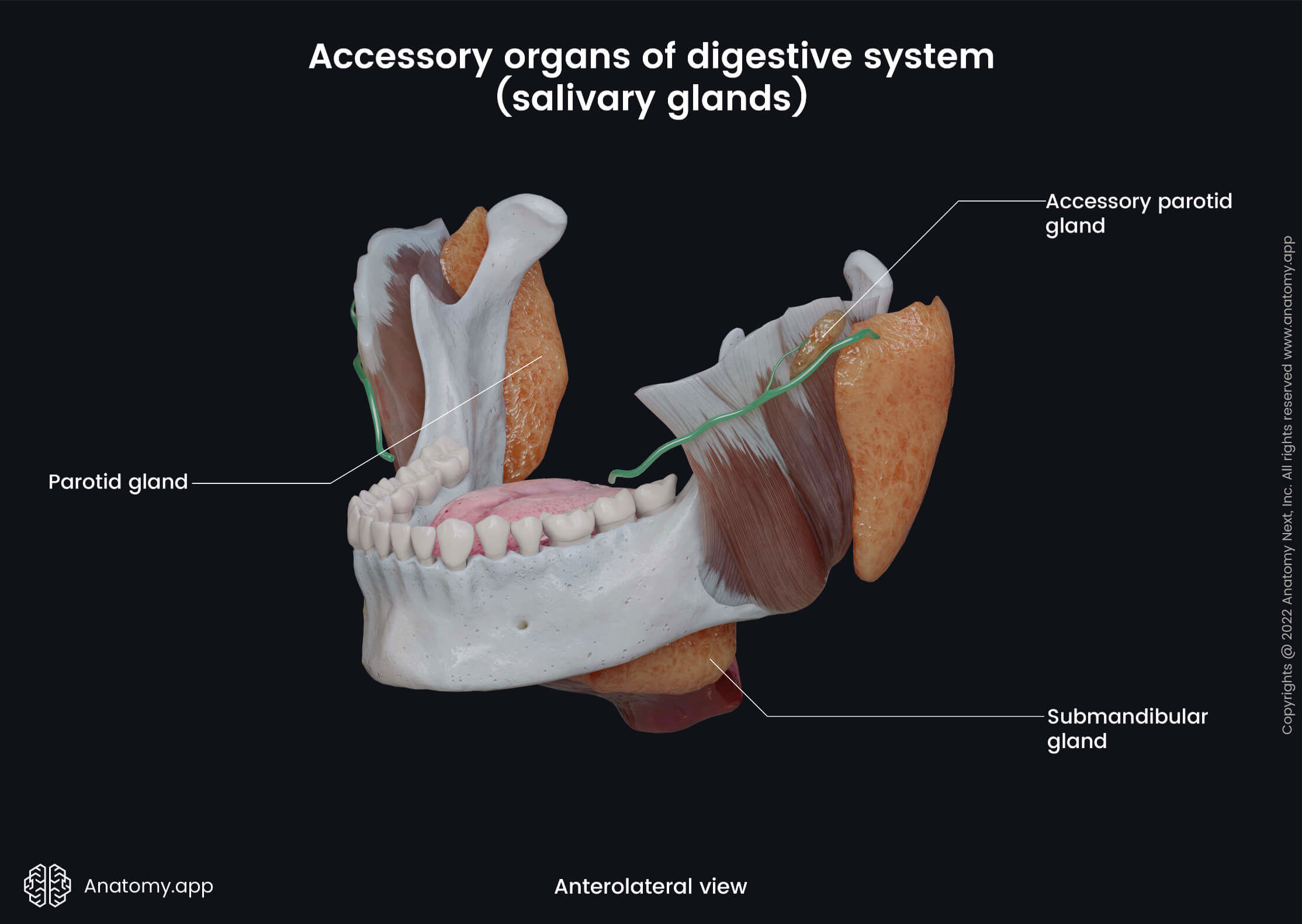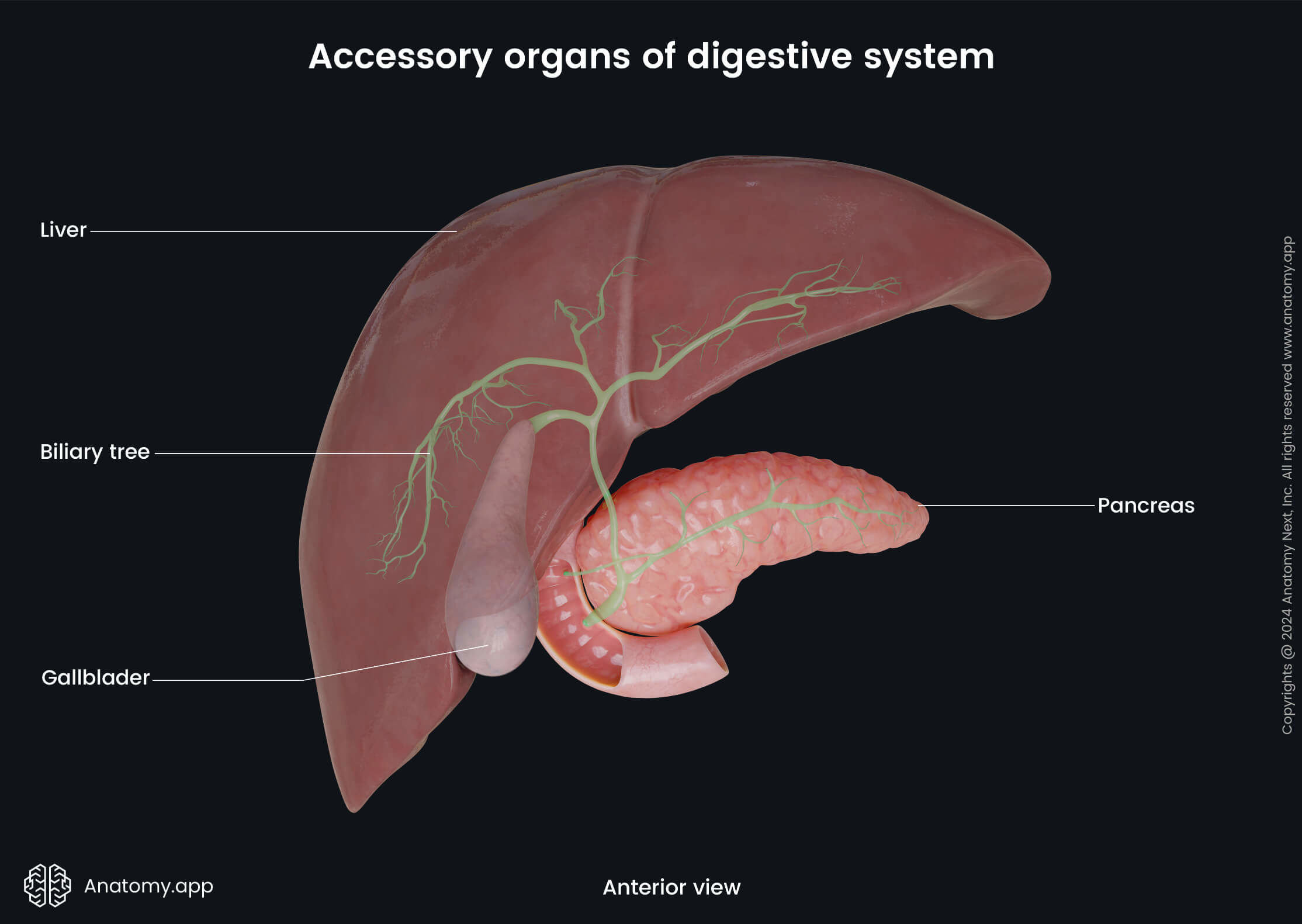- Anatomical terminology
- Skeletal system
- Joints
- Muscles
- Heart
- Blood vessels
- Lymphatic system
- Nervous system
- Respiratory system
- Digestive system
- Urinary system
- Female reproductive system
- Male reproductive system
- Endocrine glands
- Eye
- Ear
Digestive system
The digestive system (Latin: systema digestorium), also known as the alimentary system, is a complex organ system located throughout most of the body, mainly within the trunk. It is one of the largest organ systems of the human body. The digestive system includes a series of hollow organs connected to each other, starting from the mouth and ending with the anus. The organs of the digestive system provide functions related to digestion - mechanical and chemical food procession, absorption of nutrients and excretion of undigested remains.
Digestive system parts
The digestive system is located in the head, neck, thoracic and abdominal cavities and pelvis. It is composed of two main parts - the gastrointestinal tract (also known as the alimentary tract or digestive tract) and accessory organs. The length of the gastrointestinal tract varies in humans, but usually, it is about eight to ten meters long. The digestive tract length is about 4 - 5 times the size of the actual height of a person.
The gastrointestinal tract reminds a long twisting tube that starts at the mouth and ends at the anus. It mainly provides the passage and storage of the digested food. The accessory organs of the digestive system help in digestion. They are located along the length of the gastrointestinal tract, mainly within the abdominal cavity. The accessory organs secrete and synthesize various enzymes and, therefore, help to break down the food into smaller parts and nutrients.
Gastrointestinal tract organs
The gastrointestinal tract is a series of hollow organs joined together in a long tube. It includes the following organs:
- Oral cavity and its constituent structures:
- Oral vestibule (formed by the lips, cheeks, gums and teeth)
- Oral cavity proper (formed by the soft and hard palate and tongue)
- Pharynx
- Esophagus
- Stomach
- Small intestine with the following parts:
- Duodenum
- Jejunum
- Ileum
- Large intestine with the following structures:
- Cecum and vermiform appendix
- Ascending colon
- Transverse colon
- Descending colon
- Sigmoid colon
- Rectum
Accessory organs
The digestive system also includes several accessory organs, mostly various glands. In the oral cavity are located several minor and three major salivary glands (parotid, submandibular and sublingual).


Mainly in the thoracic cage is situated the largest gland in the human body - the liver. The gallbladder and biliary tree that are adjacent and related to the liver are also classified as accessory organs of the digestive system.

Within the abdominal cavity in the umbilical region lies the pancreas. And finally, the peritoneum is also considered an accessory organ of the digestive system. It is a serous membrane that lines the walls of the abdominal cavity and covers the organs within it and the pelvis.

Digestive system organs by functions
The organs of the digestive system can be grouped into three main divisions according to the primary function they provide.
- The oral cavity, pharynx and esophagus are responsible for the mechanical food procession.
- The stomach, small and large intestine, liver, salivary glands, gallbladder and pancreas mainly provide the chemical food procession and absorption of split products and nutrients.
- And the final division provides the excretion of waste products, and the rectum is responsible for it.
Digestion process
The digestive system has several functions that are mostly related to digestion as it is the primary function of the digestive system. The digestion process has three main phases - oral, gastric and intestinal phases.
Oral phase of digestion
The digestion process starts even before eating, as by just looking at the food and smelling it, the stomach and salivary glands get signals to release saliva and gastric juice. The ingestion follows when a person puts food into the mouth. At that moment, the oral cavity starts the process of food analysis provided by sensory receptors such as taste, thermoreceptors and mechanoreceptors. Also, olfactory receptors are involved in the analyzing part.
The mechanical food procession starts at the moment when the food is being chewed. The food mixes with saliva, and the chemical food procession starts. Saliva contains an enzyme called amylase that breaks down food containing starch (potatoes, bread). Saliva also contains a protein called mucin, and it helps with food hydration and lubrication.
After the chewing, the bolus is formed. It is a soft and easy swallowed mass. The tongue and muscles within the oral cavity push the bolus closer to the oropharynx located at the back of the oral cavity. The bolus goes through the pharynx and reaches the esophagus.
Gastric phase of digestion
The bolus is moved from the esophagus further to the stomach by rhythmic muscle contractions called peristalsis. The lower esophageal sphincter opens, and the bolus reaches the stomach. The stomach continues the chemical food procession, and the gastric juice breaks down the food into even smaller particles. An enzyme called pepsin breaks down the proteins. Gastric acid also has a protective role as it helps to kill bacteria and viruses. When the gastric stage of digestion is over, the gastric acid, enzymes and partially digested food have formed a milky-looking thick and viscous mixture. It is called chyme.
Intestinal phase of digestion
Chyme is moved next from the stomach via the pyloric sphincter into the duodenum. In the duodenum, chyme mixes with bile and pancreatic juice. Both acidic and enzyme-rich fluids continue to break down proteins, fats and carbohydrates. The small intestine absorbs the water, vitamins and other nutrients into the bloodstream through small structures (intestinal villi) located in the wall of the small intestine. The intestinal villi increase the overall surface area of the intestines.
Undigested and unabsorbed products are moved next to the large intestine through the ileocaecal valve found between the ileum and cecum. Any remaining water and nutrients are absorbed in the large intestine. All the waste products form the stool, and it is stored in the sigmoid colon and rectum and removed from the body through the anus by bowel movements.
Length of digestion
The time it takes the digestive system to recycle the food varies in males and females and from person to person. It depends on the metabolism and disorders associated with the digestive system. In a healthy person, the average duration of the digestion process is about 24 - 72 hours, based on several factors. Those factors include the amount and type of ingested food. The process can be as long as 96 or 120 (4 - 5 days) hours or even more in cases of various pathologies and disorders.
After the food is swallowed, it takes an average time of 6 - 8 hours to pass through the stomach and small intestine. Overall, it takes about 2 - 5 hours to empty the stomach. But to pass through the entire length of the small intestine - 2 - 6 hours. After the digested food enters the colon, the most time-consuming digestion part starts. The digested food moves through the large intestine for approximately 36 - 40 hours.
Food rich in proteins and fats, such as meat, takes a longer digestion time. But products high in fibers, such as vegetables and fruits, transit through the tract faster, as fibers help to move the food more efficiently and quicker. To compare, it takes about two days for meat and less than a day for vegetables to pass through the gastrointestinal tract. Food that contains a high amount of sugars, such as pastries and candy bars, is among the fastest digested food, and usually, it is just a matter of hours.
Digestive system disorders
Many disorders can affect and slow down digestion or even disrupt it. These conditions often present with constipation or diarrhea, flatulence (gasses), heaviness, swallowing difficulties, burning sensation and abdominal pain. The most common disorders that affect the digestive system include the following:
- Gastroesophageal reflux disease (GERD), or acid reflux - presents with regular or periodically backflow of the gastric acid from the stomach to the esophagus; it happens due to weak lower esophageal sphincter;
- Inflammatory bowel diseases - this group includes ulcerative colitis and Crohn’s disease; as the name suggests, both conditions present as severe chronic inflammation, affecting the large intestine exclusively (ulcerative colitis) or any part of the digestive system (Crohn’s disease); however, most commonly, the Crohn’s disease affects the terminal part of the small intestine (ileum) and the beginning of the large intestine;
- Celiac disease - also known as gluten-sensitive enteropathy or celiac sprue; it is classified as an autoimmune disorder; the immune system of a person attacks and damages the cells of the small intestine when a person eats gluten-containing products such as white or rye bread, couscous, wheat-based pasta and noodles, and many more products to follow;
- Irritable bowel syndrome - a widespread and lifelong disorder affecting intestines and causing stomach cramps, bloating and flatulence, abdominal pain, diarrhea and constipation;
- Diverticulosis resulting in diverticulitis - it presents with small pockets or pouches called diverticula in the walls of the large intestine, most commonly in the descending or sigmoid colon; the formation of diverticula is associated with weak sites in the large intestine wall and pressure changes; diverticulitis is characterized as an inflammation of the diverticula, and it can present as very severe pain in the abdomen, but quite often, it is asymptomatic;
- Food intolerances (lactose intolerance) and food allergies such as peanut allergy - the first one is present when it is difficult for a person to digest certain food types; in comparison, food allergy presents as an immune system response to a certain product; both conditions cause a bunch of different signs and symptoms; overall, intolerance is less severe and often presents only with symptoms associated with the digestive system; in contrast, food allergy can be critical and even life-threatening condition, depending on the immune system response; it can also present with other symptoms not only those associated with the digestive system.